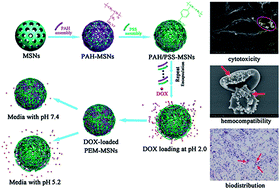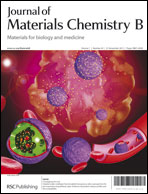Polyelectrolyte multilayer functionalized mesoporous silica nanoparticles for pH-responsive drug delivery: layer thickness-dependent release profiles and biocompatibility†
Abstract
Surface functionalization of mesoporous silica nanoparticles (MSNs) has been proposed as an efficient approach to enhance the biocompatibility and efficiency of MSN-based carrier systems. Herein, polyelectrolyte multilayers (PEMs) composed of poly(allylamine hydrochloride) (PAH) and poly(styrene sulfonate) (PSS) were coated onto the MSN surface via a layer-by-layer (LbL) technique, and doxorubicin hydrochloride (DOX) was loaded into the prepared PEM-MSNs, thus constructing potential pH-responsive carrier systems. Extensive studies were performed to evaluate their biocompatibility and efficiency, emphasizing the influences of the layer numbers on the release profiles, cytotoxicity and hemocompatibility. It is demonstrated that PEM layer thickness has an exponential relationship with the number of coated layers, and release profiles of nanoparticles were both pH- and layer thickness-dependent. PEM-MSNs exhibited a very low and layer thickness-dependent cytotoxicity against macrophage cells. They did not induce obvious hemolysis or cause significant platelet aggregation, but also did not activate any coagulation pathways. The cellular uptake of DOX-loaded PEM-MSNs in HeLa cells was remarkably larger than that in L929 cells, thus resulting in a desirable growth-inhibiting effect on cancer cells. DOX-loaded PEM-MSNs exhibited a slower and prolonged DOX accumulation in the nucleus than free DOX. In vivo biodistribution indicated that they induced a sustained drug concentration in blood plasma but lower drug accumulation in the major organs, especially in the heart, compared to free DOX. The histological results also revealed that DOX-loaded PEM-MSNs had lower systemic toxicity than free DOX. Therefore, LbL functionalization of MSNs provides the practical possibility for creating MSN-based carrier systems with low systemic toxicity and high efficiency.


 Please wait while we load your content...
Please wait while we load your content...